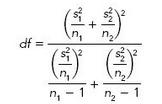Question: In small sample cases where we are estimating the difference between two population means and the population standard deviations are unknown, we used an approach
In small sample cases where we are estimating the difference between two population means and the population standard deviations are unknown, we used an approach in which we assumed that the two population standard deviations were equal. Under this assumption, we pooled the sample standard deviations and ultimately used the t distribution with n1 + n2 – 2 degrees of freedom to build our confidence interval. If we assume that the population standard deviations are un equal, we would need to modify our approach. One alternative is to produce a confidence interval using what’s known as the Welch Satterwhite method. In this procedure, we won’t pool the sample standard deviations and we’ll use the t distribution with degrees of freedom approximated by the expression

If the result of this df calculation is not an integer, it can be rounded down to the next lower integer value. The interval will look like

Situation: Aluminum can be obtained by electrically separating it from the bauxite ore that contains it. You are currently testing two new procedures to produce this separation. By applying Procedure A to 12 five ton samples of bauxite ore, you produce an average yield of 1024 lbs. of aluminum per application, with a standard deviation of 15 lbs. Applying Procedure B to 10 five ton samples of bauxite ore from the same source produces an average yield of 990 lbs., with a standard deviation of 28 lbs.
a. Use a 95% confidence level and construct the appropriate interval estimate of the difference in the average yield for the two populations represented, assuming that that the two population distributions have unequal standard deviations.
df n n2
Step by Step Solution
3.34 Rating (160 Votes )
There are 3 Steps involved in it
a NOTE THE CHANGE s 1 15 n 1 12 s 2 28 n 2 10 df 132 which rounds down ... View full answer

Get step-by-step solutions from verified subject matter experts
Document Format (1 attachment)
486-M-S-S-I (1245).docx
120 KBs Word File


